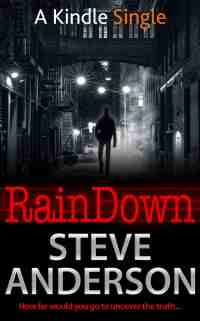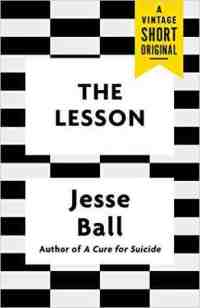Rain Down by Steve Anderson and The Lesson by Jesse Ball
 Sunday, May 22, 2016 at 10:03AM
Sunday, May 22, 2016 at 10:03AM The advent of digital publishing has made it possible for publishers to market individual short stories. Examples include Kindle Singles, Vintage Shorts, and the Bibliomysteries series. Although Tzer Island primarily reviews books, I occasionally review single stories, usually doubling up the reviews as an extra treat for readers.

"Rain Down" by Steve Anderson
Published as a Kindle Single by Endeavour Press on May 4, 2016
Rain Down is marketed as a thriller but I’d call it a noir-flavored mystery mixed with a story of self-discovery. Roughly one-fifth the length of an average novel, Rain Down might qualify as a short novella or a long short story. Regardless of its classification, Rain Down is the right length for the story Steve Anderson tells. No words are wasted here.
Rain Down is told from the perspective of a 37-year-old homeless man in Portland who works at day labor jobs with his friend Oscar Alvarez. At least he does until Oscar’s body is discovered -- dismembered parts, scattered by the train that hit it. The homeless man’s investigation of Oscar’s death causes him to have uncomfortable encounters with the man who often hired them as day laborers, with a couple of women who were connected to Oscar, and with a couple of cops.
The homeless man is odd but credible and therefore interesting. Initially homeless by circumstance, he now seems to prefer sleeping rough. He has an aversion to charity and bathing. He’s intelligent, cynical (or realistic, depending on how you view life), and caring. He’s philosophical but for much of the story, his is the philosophy of despair -- understandable, given his situation. But it’s a hopeful sort of despair, if that’s possible.
The mystery of Oscar’s death is sad but consistent with the story’s theme. The simple plot, however, is less important than the atmosphere and the characters. Anderson paints a convincing picture of life on the street. Rain Down offers a sympathetic glimpse of day laborers, although it is just a glimpse. The homeless man might not offer a perfect lesson in how to deal with adversity, but the real lesson is that everyone deals with adversity in his or her own way, and that there’s always reason to hope for a better tomorrow.
RECOMMENDED

"The Lesson" by Jesse Ball
Published by Vintage on November 3, 2015
Ezra and Loring Wesley were chess masters. Five years after Ezra’s death, Loring accepts as a chess student a 5-year-old whose chess strategy reminds her of Ezra. The boy was, in fact, born at the very moment of her husband’s death. So you can guess where this is going.
Well, probably you can’t, because the story doesn’t go anywhere. It is a collection of odd events that add up to almost nothing. I can usually understand the point an author is trying to make, even when fiction is experimental, but with The Lesson, I am simply lost. Perhaps I am too dense to make sense of it, but from my dense perspective, I find little value in the story.
This is my first experience with Jesse Ball and I have to say that his writing style, at least in this story, is too precious for my taste. The story is written in the third person. The narrator is annoyingly intrusive. The narrator asks questions that are followed with “Who can say?” or tells of a character looking out a window, followed by “What she saw is not reported” or notes that a character went into the kitchen, followed by “Something stops us from following.” If there is a point to emphasizing the narrator’s non-omniscience, I couldn’t find it.
The narrator also offers little tidbits of wisdom like “of what we are capable, we seldom know” or “our personalities, our selves, border on the possible, and when the possible grows, well, so then do we.” A little of that is fine but I grew weary of Jesse Ball’s pop philosophy. I like a narrator to narrate and otherwise to stay out of the way. Granted, some writers are capable of chatting with the reader while telling a story, but Ball doesn’t seem to be one of them.
Many scenes are written in fine prose. Many would fit neatly into an absorbing story. Sadly, that is not the story that Ball wrote.
NOT RECOMMENDED



